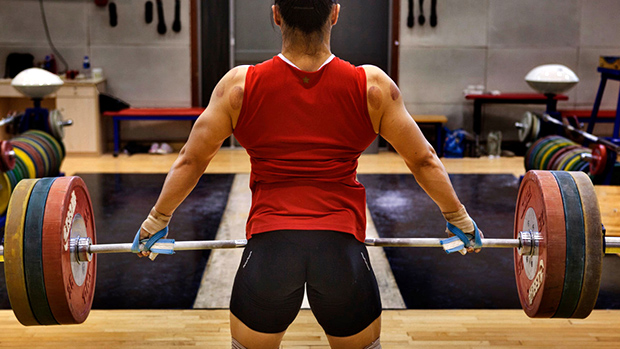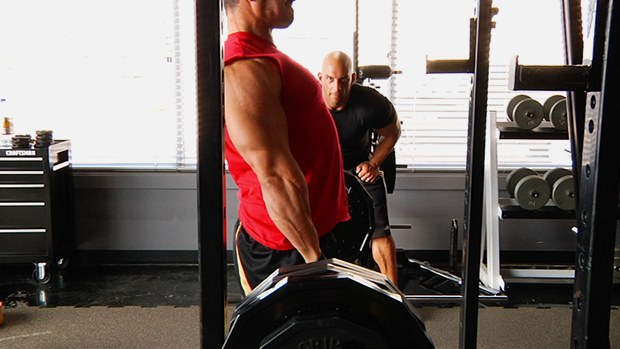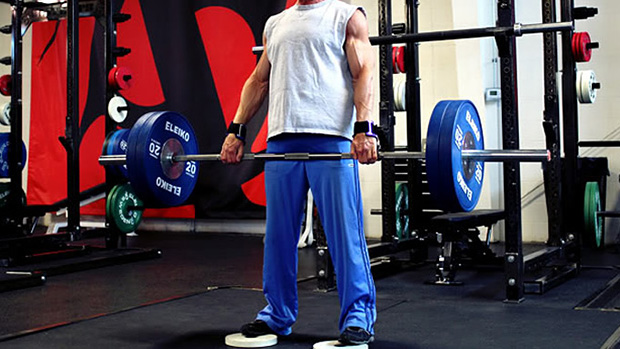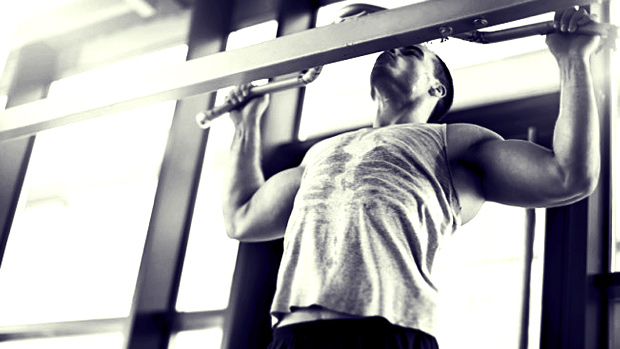So you think you know everything about the bench press? Watched a lot of YouTube videos? Maybe even had a coach or personal trainer? Well, here's what you still might be missing.
First let's make sure we have the basics of bench pressing covered:
- Head, upper back, butt, and feet are in contact with the ground.
- Shoulder blades are retracted to keep the chest up high. Back is mildly arched.
- Bar is lowered to nipple line, with the elbows held vertically underneath.
- Bar is pressed to above shoulder line without overreaching and losing shoulder blade retraction.
Now that the Coles Notes are out of the way, let's explore the idea of floor drive. Remember, we're pushing the bar away from our chest, but in reality we're still pushing the bar away from the floor. We're just sandwiched between the two horizontally. If we want to maximize the force we produce, we should also be pressing into the floor.
A mistake I see many people make when trying to establish floor drive, however, is missing the proper foot position to make it happen. The classic "keep the knees bent at 90 degrees with the feet flat on the ground" cue is serviceable under lighter loads, but can throw mechanics off when you're fatigued or lifting heavy.
Too big an angle at the knee joint (and a flat-footed position) encourages pressure through the full foot and encourages the hips to rise off the bench, which is not only inefficient, but also just plain looks horrible and embarrassing.
It's a bit harder to do this when in a properly tucked position with the knees just shy of a 90-degree angle, the heels slightly off the ground or in very light contact, and the balls of the feet and toes doing most of the driving.
Since the pressure and force you'll be creating through the feet will not only drive downward, but also slightly forward, you'll apply better tension through the quads and help engage your anterior chain more effectively for a good quality press. Try it.
The pin press doesn't get enough love, and it should. Not only does it protect the shoulders by reducing range of motion – the most vulnerable range of motion at that – but it also allows a lifter to press from a dead stop on each rep.
That's huge for strength development since there's no transfer of force or momentum that can be carried through from rep to rep. It makes the most of a very uncompromising situation and will certainly allow you to sustain your heavy lifting by years.
Isometric work creates positional strength at various joint angles and can also increase mobility, which can improve the quality of typical isotonic movements. In this case, however, setting up a bench press for an isometric is a great way to charge up the nervous system before a heavy workout.
You can even use this method as its own workout by simply adding time and volume to the isometric sets. The idea is to exhaust the high threshold motor units and repeat sets of 15 seconds or so in length.
The key is to work literally as hard as you can. If there's anything you're leaving in the tank, these won't work effectively. And remember, your chances for injury with isometrics are low. Without motion, there's much less risk for things to go wrong as long as technique is true, so select your desired joint angle and go to town.
The easiest way to set up an isomeric situation is on the Smith machine. Lower the bar to the preferred joint angle and then overload the rack. The weight you choose should be something you can't budge. It's the only way this will work.
Perform 1 to 2 sets before your heavy bench press workout to get as much as you can out of those muscles in subsequent sets.
For clarity, a compound set is not a superset. Supersets deal with back-to-back exercises that involve unrelated muscle groups – like pairing bench press with rows or biceps curls.
Compound sets involve back-to-back exercises using the same or synergistic muscle groups, like pairing bench press with pec flyes or dips. These are a surefire way to chase exhaustion and make muscles grow. My favorite chest compound set is simple yet insanely humbling: A bench press variation followed by a push-up variation.
It doesn't matter what version you choose for the press – dumbbell, barbell, incline, or decline are all fine. It also doesn't matter what version you choose for the push-up. Rings, flat ground, close grip, and feet elevated all work well.
The real key is the fact that the bench press exposes you to lower-rep heavy stuff, and the push-up pattern will go back to allowing the shoulder blades to move freely during a horizontal push.
If you want to take things up even further, turn your compound set into a contrast set. A contrast set "tricks" your muscles into using more fast twitch muscle fibers than they normally would by first priming them with a "heavily" loaded version of the pattern.
In the case of the bench press/push-up combo described above, it would mean following up low-rep bench presses with plyometric push-ups where the hands leave the floor.
The rules are simple. If you're benching for 3 reps, you don't need to use your actual 3RM weight. If you did, there wouldn't be any juice left for much else. Focus on weight you can accelerate while still appreciating the load. If you're normally repping 315 for 3, bring it down to a solid 265.
When you segue to the plyo push-ups, don't hold back. Aim for some good force production and get some air. Really take off. And of course, know how to land. Focus on at least double the amount of reps in your push-up as your bench press. Sets of 6-8 plyo push-ups would be sufficient.
Training with dumbbells is a great choice when there's no one there to help you. But it's cumbersome to lift the heaviest dumbbells into position for a true strength training workout. And most people would agree that dumbbell training and low reps tend not to go well together.
So if you're stuck bench pressing without the help of a spotter, you've gotta know what to do so you don't take your own head off.
First, Ditch the Collars
Don't put collars on the bar when you bench heavy by yourself. If you get pinned by the bar, you can always tip the bar from one side to the other so the weights will slide off and allow you to escape. Better a couple of cracked floor tiles than a set of cracked ribs or bruised trachea.
Pause Like a Powerlifter
This will make your lifts much more honest and make lighter weight feel heavy. Chances are you're used to glancing the bar off your chest and using a very even tempo when training. There's nothing wrong with that, but it leaves no escape plan if the weight starts feeling too heavy, and once you've failed, you've really failed.
If you can bench 300 the conventional way, you'll probably only be able to bench 255 when you lower the weight for 3 seconds and do a full 1-second pause on the chest before pressing. Lower absolute loading is a wise choice when you're not lifting with a partner. Save the lifetime PR attempts for lifting days with your buddies.
Use Cluster Reps and Sets
These are especially valuable when working with heavy weights, spotter-free.
If you're getting fatigued, OR you're trying to lift, say, your 5RM for the day, break the set down into a cluster set: do 3 reps, rest for 10 seconds, and then finish off the last two. It's guaranteed the set will go better.
The rationale behind clusters is to give your body a mid-set, 10-15 second rest to rejuvenate some ATP to give you enough juice to squeeze out an extra rep or two. Use this to your advantage even if the name of the game isn't pushing PRs.
Go to Technical Failure, Not Absolute
Training the bench to failure most commonly means performing reps until you can no longer press the bar off your chest. That's where a spotter would come in handy.
However, without a spotter, going for technical failure is the best way to stay on top of your form and technique while staying safe. Just stop the set when you know your form is starting to break down. If you feel your hips raising or your shoulder blades "reaching" away from the bench, it's time to call it a set. Don't push it. End the set immediately.
It's not worth risking an injury while you're alone by trying to push past a threshold that didn't need to be pushed. That's training smart.





